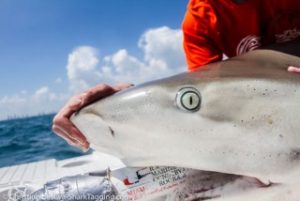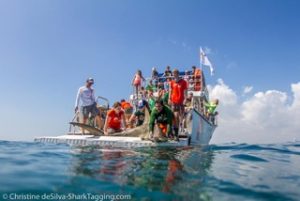Shark Tagging with Grand Classroom Ohio
By Rachel Skubel, SRC Intern
There was a special feeling among the shark research crew before setting off today – a pregnant fog had rolled over Miami, giving way to a magnificent sunrise as we drove in to the marina. It was the Ides of March, and on this iteration the ocean was so still and glassy it looked like a calm lake. Fortunately for our purposes, these conditions were perfect for heading some miles offshore of Miami into the Atlantic, enhancing our chances of sampling large pelagic species like great hammerhead sharks. Accompanying us was a group of highschool students from Ohio, so we were excited to share the wonders of our subtropical marine environment with these northerners.
Immediately after setting our first round of ten lines, we headed back to line #1 because it was on the move – was something dragging it? Yes! Our first shark of the day was a beautiful great hammerhead shark (Sphyrna lewini), a special and valuable source of blood and morphological samples for our labs’ projects. We had the fortune of witnessing a vibrant sailfish breach next to the boat as we maneuvered this animal in – it appeared that all sorts of oceanic predators were abundant through this fishing site.

A dusky shark (Carcharhinus obscurus). The pump provides the animal with highly oxygenated water throughout the quick workup.
Shortly after releasing this shark, we came upon a massive bull shark – another amazing large coastal shark we are always excited to sample! We seemed to be in great luck with our choice of site. The best, however, was yet to come. The next time we had a fish on a line, we were all excited to see what seemed to be another great hammerhead shark – but why was the dorsal fin smaller? And the coloration seemed bronzy! Indeed, our hopes were confirmed when we pulled in a scalloped hammerhead shark (Sphyrna lewini) – one of only a few our lab has ever worked with! This was a truly rare opportunity for tissue samples and morphological measurements. As excited as we were with this species, we were soon to encounter a dusky shark – the fourth in SRC’s history!

A great hammerhead shark (Sphyrna mokarran) is released after tissue samples and measurements are taken.
Along with these animals, we also sampled a second great hammerhead shark – which we satellite tagged, a nurse shark, and the first sandbar sharks of 2016. Truly, this was an immensely valuable day for our lab’s projects and we were happy to have shared it with a lucky group of highschool students. Stay tuned for this great hammerhead shark’s location on our live satellite-tracking page at https://sharkresearch.rsmas.miami.edu/education/virtual-learning/tracking-sharks!
